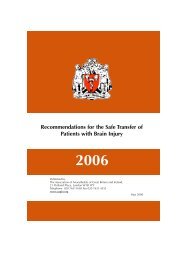TheatrePracticeStandardsGeneric1
Create successful ePaper yourself
Turn your PDF publications into a flip-book with our unique Google optimized e-Paper software.
1. Detailed guidelines including list of equipment required for Last Offices:<br />
Preparing the Body (These should be laminated and placed in the Last Offices<br />
Box)<br />
<br />
<br />
<br />
<br />
Personal Protective Equipment (disposable<br />
gloves, aprons, goggles relative to the risk of<br />
body fluid exposure.)<br />
Bowl of warm water, soap, disposable wash<br />
cloths and two towels.<br />
Equipment List:<br />
Disposable razor, comb and equipment for nail<br />
care.<br />
Equipment for mouth care including equipment for<br />
cleaning dentures.<br />
<br />
<br />
<br />
<br />
Gauze, waterproof tape, dressings and<br />
bandages if wounds or intravenous<br />
arterial lines and cannula are presen.t<br />
Receiver for collecting urine if<br />
appropriate.<br />
Plastic bags for clinical (yellow),<br />
household waste (black), laundry (red).<br />
Sharps bin.<br />
Identification labels x 2. Clean sheet.<br />
<br />
<br />
<br />
Documents required:<br />
- Mortuary Card (A5 yellow)<br />
- Notification of Death for Bereavement Office<br />
(A4 White)<br />
<br />
<br />
Record book for property and<br />
valuables.<br />
Bags for the patient’s personal<br />
possessions.<br />
Shroud or patient’s personal clothing if previously requested by patient, or clothes that comply<br />
with family or cultural wishes.<br />
Body bag and labels for the body bag including labels that identify any known infection/disease.<br />
2. Detailed Procedure of ‘Last Offices’ for a Perioperative Patient<br />
1 Ascertain if the family has any preferences or knowledge of the preferences that the<br />
patient, in life, may have requested that will influence last offices practice.<br />
2 Collect all equipment necessary.<br />
3 Ensure the area where the procedure is to be performed is private and as free from<br />
interruptions as possible.<br />
4 Remove all but one pillow. Support the jaw by placing a pillow or rolled up towel on the chest<br />
or underneath the patients jaw.<br />
5 Do not bind the patients jaw with bandages as this can leave pressure marks on the face<br />
which can be difficult to remove.<br />
6 Remove any mechanical aids such as syringe drivers, heel pads etc. Apply gauze and tape<br />
to syringe driver sites and document disposal of medication.<br />
7 Straighten patient’s limbs.<br />
8 If lines are to remain, cut and cap/spigot off any large-bore tubes and cover with gauze and<br />
adhesive dressing. Ensure that documentation alerts mortuary staff to their presence. Do not<br />
remove any invasive lines.<br />
9 Attempt to close the patient’s eyes by using gentle pressure to the eyelids for 30 seconds,<br />
using a small piece of clinical tape if required.<br />
10 Apply gentle pressure over the bladder area, if the patient is not catheterised, allowing the<br />
bladder to drain. This will minimise the risk of post-mortem leakage.<br />
51





